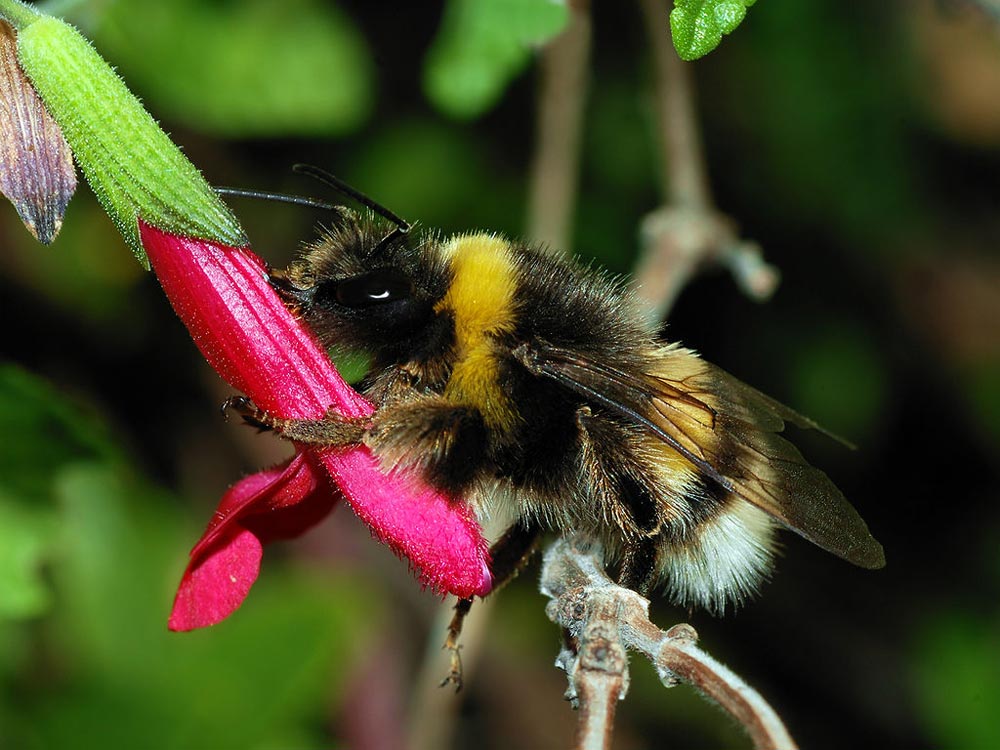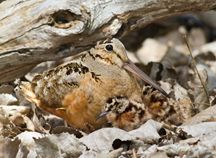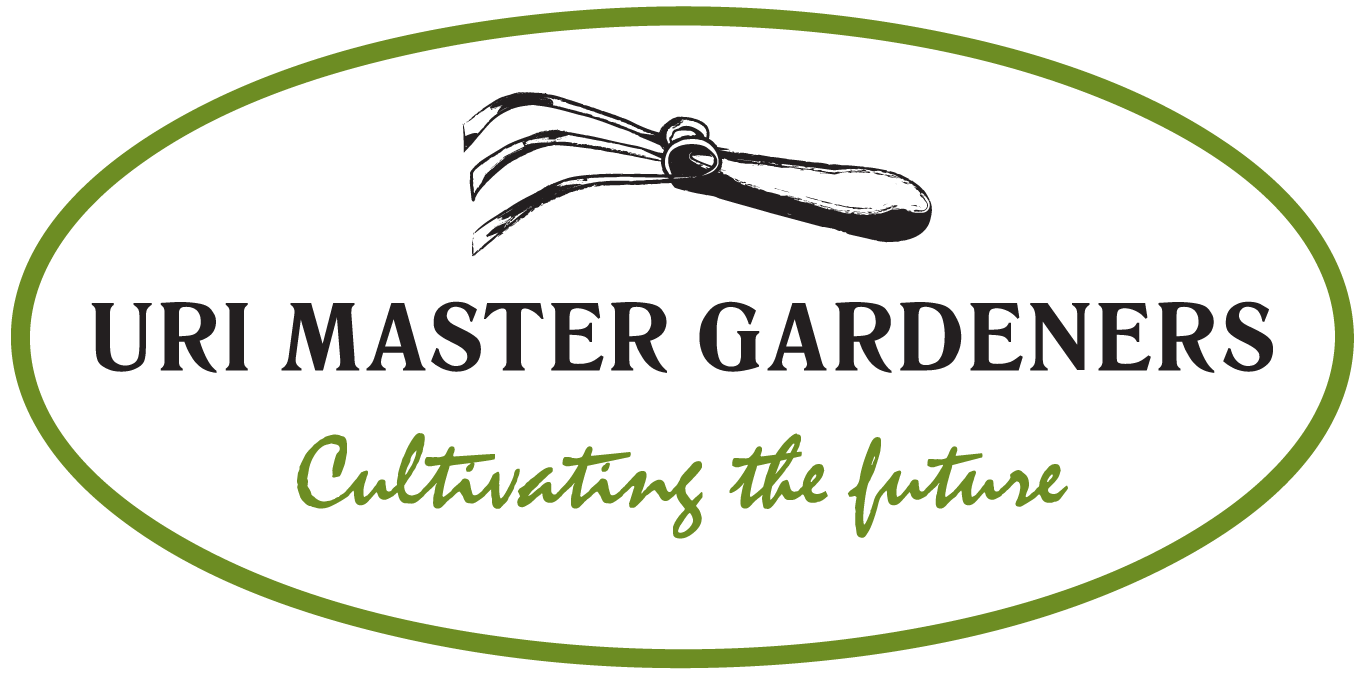URI MGP Newsletter, April 6: Pollinator Lectures from Visiting Scholar, Caterpillars and Woodcocks
April Flowers - Visiting Scholar to teach about Pollinators!
Join the URI Community in welcoming J. Scott MacIvor, a post doctoral researcher from the Department of Biological Science at the Unviersity of Toronto Scarborough. Please invite your friends and family as all lectures below are open to the public and count toward URIMGP Continuing Education credit. Please sign up in Volgistics.
The URI Master Gardener Program is pleased to partner with the following sponsors to make these lectures possible: CELS Dean’s Office, URI Dept. of Natural Resource Science, RI Natural History Survey.
 Are cities wild bee conservation hotspots or not-spots?
Are cities wild bee conservation hotspots or not-spots?
Where: URI Kirk Auditorium, Engineering Building
When: April 27th, 11 am- 12:15 pm
In this talk, we will explore the recent research findings from cities around the world that examine the local and landscape factors affecting wild bees in cities. We’ll examine a case study from our work in the city of Toronto that illustrates the complex influences of infrastructure, urban green space, and socioeconomics on the diversity and pollination services of wild bees.
Cutting Edge Pollinator Conservation & Communicating Science to the Public
Where: URI Pharmacy Building Room 170
When: Thursday, April 27th, 6:00 pm – 8:30 pm
 Enhancing wild bees in cities: Practical approaches for home and community gardeners
Enhancing wild bees in cities: Practical approaches for home and community gardeners
In this talk, we will evaluate practical ways in which home and community gardeners can encourage wild bee diversity and abundance. We’ll examine the life history of five bee groups and how to integrate their nesting and foraging requirements into urban gardens. We will contrast honey beekeeping versus gardening for wild bees, and explore how ‘scaling up’ with citizen science can contribute to knowledge, action, and municipal support.
Getting Your Point Across: Tailoring Technical Knowledge for Broader Audiences
As a Master Gardener, you have a deep base of knowledge to share about horticulture, soil science, and food systems. But your target audience may not share your familiarity with this scientific jargon and research. In this presentation and micro-workshop, a science communication expert from URI’s Metcalf Institute will present tips for communicating with non-experts in ways that are relevant and interesting. Participants will work on crafting clear and concise messages for their target audiences.
The mission of Metcalf Institute is to expand accurate environmental news coverage through innovative training and resources for journalists, researchers, and other science communicators to engage more people in discourse about science and the environment.
Integrating ‘bee hotels’ and other design for pollinators into urban planning
Where: URI East Farm, Building 75
When: April 28th, 10:00 am -11:30 am
In this talk, we will focus in on cavity-nesting bees and the design of artificial analogs of their natural nesting conditions; in this case, the ‘bee hotel’. Many designs exist and we will explore the pros and cons of each as well as how to best construct, place, and maintain bee hotels to support wild bees and other useful insects. We will contrast these efforts with urban meadow construction and end with a discussion on bees in urban planning using ground-nesting bees in Toronto as an example.
Grants for Elementary Environmental Education Awarded to Melissa Guillet, URIMG CLass of 2011
 Waddington Elementary in Riverside received $250 from the RI Environmental Council/Loraine Tisdale Grant to produce students’ illustrations of creek animals as “Don’t Litter” signs that will be installed at three locations in East Providence and Barrington along the Annawamskutt creek. They, Master Gardener Melissa Guillet, and Barrington Land Conservation Trust member Sandra Wyatt have studied the creek with 8th grade students at St. Luke’s, which runs between the two schools. Next, Melissa is looking at ways to reduce exotic plant species and return native ones. Spicebush will be the first of these to add. More at her blog: http://15minutefieldtrips.blogspot.com/search?q=creek
Waddington Elementary in Riverside received $250 from the RI Environmental Council/Loraine Tisdale Grant to produce students’ illustrations of creek animals as “Don’t Litter” signs that will be installed at three locations in East Providence and Barrington along the Annawamskutt creek. They, Master Gardener Melissa Guillet, and Barrington Land Conservation Trust member Sandra Wyatt have studied the creek with 8th grade students at St. Luke’s, which runs between the two schools. Next, Melissa is looking at ways to reduce exotic plant species and return native ones. Spicebush will be the first of these to add. More at her blog: http://15minutefieldtrips.blogspot.com/search?q=creek
Melissa Guillet also received the “Wheels to Woods’ grant through the Rhode Island Environmental Education Association for her fourth graders to bus to a managed forest and compare it to the biodiversity in their own schoolyard. They’ve studied the trees’ leaves, used them in art, collected moss and lichen off them, examined microscopic animals, looked for other evidence of animals such as burrows, nests, food remains, tracks, and scat, and are now mapping the schoolyard for areas that support biodiversity.
The school is having an evening celebration of science and reading April 27th and Melissa will be displaying her students’ art/science projects, many of which are garden-focused and you’re welcome to attend. It will be 6:30-8 at 101 Legion Way, Riverside, RI.
Lastly, Green Teacher in Toronto (https://greenteacher.com) has selected two of Melissa’s videos for their environmental education website and she will be doing a story for them this summer. You can view the videos below:
https://www.youtube.com/watch?v=cvpB8NWK-lY&t=74s
https://www.youtube.com/watch?v=JaDG9aR7nnE&t=70s
March Master Gardener Meeting
At our March MG meeting we met our brand new URI Plant Sciences Department faculty member, Dr. John Taylor. Dr. Taylor spoke on Resilient Landscapes as it relates to our “Land Stewardship” focus area. Vanessa Venturini explained our new URI Master Gardener Program “focus area” of getting folks excited about improving the environment starting in their backyard. Learn more about it by logging in to the URI Master Gardener Program website (password – seeds) and finding it under the Continuing Education Class Recording. Here: https://web.uri.edu/mastergardener/march-23-2017-march-master-gardener-meeting/
American Woodcock Study
 Do you love birds and the great outdoors? Have you ever wished you could participate in scientific research, but aren’t sure how to get involved? Well, now’s your chance to participate in a citizen science study on a unique forest bird—the American Woodcock!
Do you love birds and the great outdoors? Have you ever wished you could participate in scientific research, but aren’t sure how to get involved? Well, now’s your chance to participate in a citizen science study on a unique forest bird—the American Woodcock!
Come meet and chat with URI scientists at our orientation on Thursday, April 13th from 6pm to 8pm in the Coastal Institute on the Kingston campus (room TBD). At this orientation, you will learn about:
- The history of the American woodcock population in the northeast
- Woodcock breeding behavior (aka “sky dances”)
- Early successional forest habitats in the northeast, and how they have been changing over time
- Some of the research mysteries that still remain about woodcock
- How to look and listen for woodcock, and how to enter count data and habitat descriptions into a data sheet.
Since we’ll be going outside, you’ll want to wear good shoes that can withstand a little bit of mud and dampness!
The time commitment will be relatively light compared to most citizen science studies. You’ll need to attend the two-hour orientation and conduct roughly 6 surveys from mid-April to mid-May that will each only last about one hour. Please contact the coordinator of the study, Erin Harrington, by April 7th if you would like to participate. You can contact her at e_harrington@my.uri.edu, or stop by her office in the URI greenhouses, Room 205. In the meantime, if you’d like to learn more about the American Woodcock and early successional forests, please check out the Woodcock Management Plan at www.timberdoodle.com. Hope to see you in April! The training will count as Continuing Education hours for URI Master Gardeners.
Gardening with the Masters Tour
 Make a wish at this little pond, then move to other spectacular sites at this Charlestown property. Gardening with the Masters, June 24 & 25. Tickets $20, available online soon. For sale in person at the URI Spring Festival and May MG Meeting.
Make a wish at this little pond, then move to other spectacular sites at this Charlestown property. Gardening with the Masters, June 24 & 25. Tickets $20, available online soon. For sale in person at the URI Spring Festival and May MG Meeting.
April Caterpillar Update from URI Cooperative Extension

Winter Moth
April 4, 2017
I expect winter moth eggs to start hatching later this week or early next week in Rhode Island, except in areas close to the coast where egg hatch is always later. No eggs have started to turn blue yet, but I expect to see blue eggs soon. (Winter moth eggs turn blue about 2 days before hatching.) I will send out another email when we find eggs actually turning blue.
For those of you planning to spray a dormant oil to help control winter moth eggs, this week is a good week to apply a 2-3% dormant oil solution. Dormant oil can suffocate overwinter eggs and is most effect when applied close to when eggs hatch. Dormant oil should not be applied if temperatures are expected to go below 40 degrees for 48 hours after application.
Those of you wanting to protect apples, pears and blueberries from winter moth caterpillars should plan on applying an insecticide soon – once winter moths start hatching in your area. Since winter moth caterpillars do not feed as they crawl into buds, a contact insecticide is needed. Unfortunately, a Bt insecticide such as DiPel or Biobit is not effective against newly-hatched caterpillars since Bt must be ingested to be effective. Insecticide choices to control hatching caterpillars for fruit growers include spinosad and Imidan. Spinosad product are Delegate (for commercial growers), Entrust (for organic growers), and Captain Jack’s Deadbug Brew (for backyard growers). Adding a dormant oil may increase effectiveness of these insecticides.
It depends on the weather whether or not one insecticide application can sufficiently control winter moth caterpillars. Rain reduces effectiveness of insecticides; and cool temperatures extend how many days it takes for all overwintering winter moth eggs to hatch. My team of egg monitors will tell me when eggs start to turn blue, when they start to hatch and when eggs have completed hatching. Eggs are being monitored in Cumberland, Smithfield, North Scituate, Warwick, North Kingstown, South Kingstown, Charlestown, Jamestown, Tiverton, Little Compton, and Westerly, RI, Franklin, MA, Hanson, MA, and Pawcatuck, CT.
Once winter moth caterpillars are inside buds, they are protected from insecticides; so to protect this year’s fruit crop, it is important to apply an insecticide to fruit buds when eggs start hatching.
Once buds open, B.t. kurstaki products (Bacillus thuringiensis kurstaki) such as DiPel and Biobit work well controlling winter moth caterpillars. For landscape trees, caterpillars can be controlled with B.t. kurstaki (Dipel Pro, Javelin and others) or spinosad (Conserve) after leaves emerge. B.t. products are a good choice because they kill only caterpillars; but B.t. products break down in sunlight after 3-5 days so may need to be reapplied more frequently. Most other insecticides will kill bees in addition to winter moth caterpillars, so do not apply insecticides to blooming plants or near blooming plants.
Want a stunning, four-season, sustainable garden? Short on space, time, and energy?
Kerry Mendez is a nationally-acclaimed gardening author, speaker, instructor, and designer. Her mission is to provide everyone (including people busy with careers, growing families, those downsizing or space-limited, or the physically challenged) the tools to create a right-sized, extremely low maintenance garden that will be a year-round joy with minimal effort. Her personal story, inspirational ideas, and practical knowledge and materials will change the way that you think about gardening!
June 2, 6-8pm (program details)
Superhero Plants for the Right-Sized Flower Garden
Register for $10 in our store or by phone (860-464-8400).
Book signing to follow presentation.
June 3, 9am-Noon (program details)
3-Hour Garden Design and Remarkable Plants Class
Register online for $49* at pyours.com/events/ (scroll to June).
*$44 for Master Gardeners (must pay by check).
Come to Holdridge’s after the class for Kerry’s book signing –
we’re a short walk or drive north of the event hall on Rt 117.
We’ll have refreshments and door prizes at both sessions.
Attendees will receive a $5 coupon toward a future plant purchase.
Please register soon as space may be limited.
Directions: 718 Colonel Ledyard Highway, Ledyard, CT 06339 (see map). Both sessions will be held in the Fellowship Hall of Ledyard Congregational Church. Enter the driveway to Bill Library and park in front of the hall or down the hill to the right (follow the signs). Please do not park in front of the library.
Holdridge Home & Garden Showplace
749 Col. Ledyard Hwy. Ledyard, CT 06339
860-464-8400
Hot Topics from the URI Consumer Horticulture Educator
 The following science-based articles may help you answer questions from the community. Rosanne Sherry, URI Consumer Horticulture Educator, recommends you read them to help sharpen your own gardening and educator skills! Please send comments or suggestions for articles to rsherry@uri.edu.
The following science-based articles may help you answer questions from the community. Rosanne Sherry, URI Consumer Horticulture Educator, recommends you read them to help sharpen your own gardening and educator skills! Please send comments or suggestions for articles to rsherry@uri.edu.
Check this site for updates on the Monarch butterflies migration. http://bit.ly/2narCDI
Worth reading from New Terrain Feb. 15, 2017
Gardening for Native Bees by Jessie Keith in The American Gardener.
The 2017 Perennial Plant of the Year, and Other Milkweeds You Should Know by Justin Wheeler on the Xerces Society blog.
Growing Agrihoods: The Next Frontier in Urban Revitalization by Julia Travers on Civil Eats.
Designer Puts Tallamy’s Advice into Practice by Susan Harris on GardenRant.
The secret life of trees: Is nature less selfish than we think? by Paula Erizanu for CNN.
Deer change the landscape indirectly by Terry Devitt on Phys.org.
Management, Not Maintenance by Thomas Christopher on GardenRant.
Bird-Friendly Communities: Grow These Native Plants So Your Backyard Birds Can Feast by Zach Slavin for Audubon’s blog.
From UMASS Hort Notes February 2017Vol. 28 No. 1
Winter injury to coniferous trees and shrubs in the landscape
Evergreen conifers in the landscape can suffer freeze injury during the winter months when they are exposed to subzero air temperatures along with strong winds. The record cold temperatures the northeast experienced over the Valentine’s Day weekend in 2016 is a good example of conditions capable of causing injury to landscape conifers.
While most northern temperate conifers are adapted to withstand very cold temperatures, various stresses can affect cold hardiness. Conifers may become susceptible to freeze injury after drought, insect infestation or a disease outbreak disrupts their ability to properly acclimate to cold weather. Additionally, freeze injury can occur after a partial deacclimation of cold hardiness takes place due to above-average temperatures in late winter or early spring.
Symptoms become visible in the spring when temperatures warm and appear as needle browning, premature needle shedding and stem/branch dieback. Conifers that are recently transplanted (especially eastern hemlock) and those planted in open settings exposed to harsh winds are more likely to suffer freeze injury during the dormant period. When freeze injury is identified, these killed plant parts should be pruned and removed to avoid colonization of the dead tissues by opportunistic insect pests and fungal pathogens.
 Home
Home Browse
Browse Close
Close Events
Events Maps
Maps Email
Email Brightspace
Brightspace eCampus
eCampus


